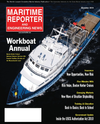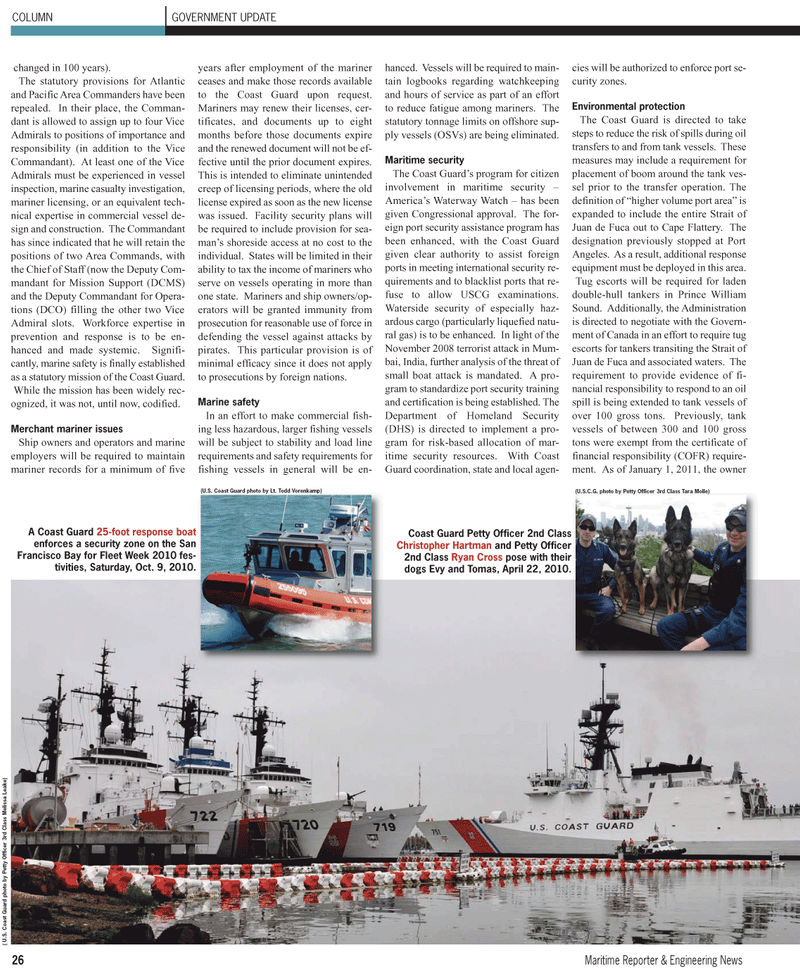
Page 26: of Maritime Reporter Magazine (November 2010)
Workboat Annual
Read this page in Pdf, Flash or Html5 edition of November 2010 Maritime Reporter Magazine
26 Maritime Reporter & Engineering News changed in 100 years).
The statutory provisions for Atlantic and Pacific Area Commanders have been repealed. In their place, the Comman- dant is allowed to assign up to four Vice
Admirals to positions of importance and responsibility (in addition to the Vice
Commandant). At least one of the Vice
Admirals must be experienced in vessel inspection, marine casualty investigation, mariner licensing, or an equivalent tech- nical expertise in commercial vessel de- sign and construction. The Commandant has since indicated that he will retain the positions of two Area Commands, with the Chief of Staff (now the Deputy Com- mandant for Mission Support (DCMS) and the Deputy Commandant for Opera- tions (DCO) filling the other two Vice
Admiral slots. Workforce expertise in prevention and response is to be en- hanced and made systemic. Signifi- cantly, marine safety is finally established as a statutory mission of the Coast Guard.
While the mission has been widely rec- ognized, it was not, until now, codified.
Merchant mariner issues
Ship owners and operators and marine employers will be required to maintain mariner records for a minimum of five years after employment of the mariner ceases and make those records available to the Coast Guard upon request.
Mariners may renew their licenses, cer- tificates, and documents up to eight months before those documents expire and the renewed document will not be ef- fective until the prior document expires.
This is intended to eliminate unintended creep of licensing periods, where the old license expired as soon as the new license was issued. Facility security plans will be required to include provision for sea- man’s shoreside access at no cost to the individual. States will be limited in their ability to tax the income of mariners who serve on vessels operating in more than one state. Mariners and ship owners/op- erators will be granted immunity from prosecution for reasonable use of force in defending the vessel against attacks by pirates. This particular provision is of minimal efficacy since it does not apply to prosecutions by foreign nations.
Marine safety
In an effort to make commercial fish- ing less hazardous, larger fishing vessels will be subject to stability and load line requirements and safety requirements for fishing vessels in general will be en- hanced. Vessels will be required to main- tain logbooks regarding watchkeeping and hours of service as part of an effort to reduce fatigue among mariners. The statutory tonnage limits on offshore sup- ply vessels (OSVs) are being eliminated.
Maritime security
The Coast Guard’s program for citizen involvement in maritime security –
America’s Waterway Watch – has been given Congressional approval. The for- eign port security assistance program has been enhanced, with the Coast Guard given clear authority to assist foreign ports in meeting international security re- quirements and to blacklist ports that re- fuse to allow USCG examinations.
Waterside security of especially haz- ardous cargo (particularly liquefied natu- ral gas) is to be enhanced. In light of the
November 2008 terrorist attack in Mum- bai, India, further analysis of the threat of small boat attack is mandated. A pro- gram to standardize port security training and certification is being established. The
Department of Homeland Security (DHS) is directed to implement a pro- gram for risk-based allocation of mar- itime security resources. With Coast
Guard coordination, state and local agen- cies will be authorized to enforce port se- curity zones.
Environmental protection
The Coast Guard is directed to take steps to reduce the risk of spills during oil transfers to and from tank vessels. These measures may include a requirement for placement of boom around the tank ves- sel prior to the transfer operation. The definition of “higher volume port area” is expanded to include the entire Strait of
Juan de Fuca out to Cape Flattery. The designation previously stopped at Port
Angeles. As a result, additional response equipment must be deployed in this area.
Tug escorts will be required for laden double-hull tankers in Prince William
Sound. Additionally, the Administration is directed to negotiate with the Govern- ment of Canada in an effort to require tug escorts for tankers transiting the Strait of
Juan de Fuca and associated waters. The requirement to provide evidence of fi- nancial responsibility to respond to an oil spill is being extended to tank vessels of over 100 gross tons. Previously, tank vessels of between 300 and 100 gross tons were exempt from the certificate of financial responsibility (COFR) require- ment. As of January 1, 2011, the owner
A Coast Guard 25-foot response boat enforces a security zone on the San
Francisco Bay for Fleet Week 2010 fes- tivities, Saturday, Oct. 9, 2010.
COLUMN GOVERNMENT UPDATE ( U.S. Coast Guar d photo by Petty Of ficer 3r d Class Melissa Leake) (U.S. Coast Guard photo by Lt. Todd Vorenkamp) (U.S.C.G. photo by Petty Officer 3rd Class Tara Molle)
Coast Guard Petty Officer 2nd Class
Christopher Hartman and Petty Officer 2nd Class Ryan Cross pose with their dogs Evy and Tomas, April 22, 2010.

 25
25

 27
27
